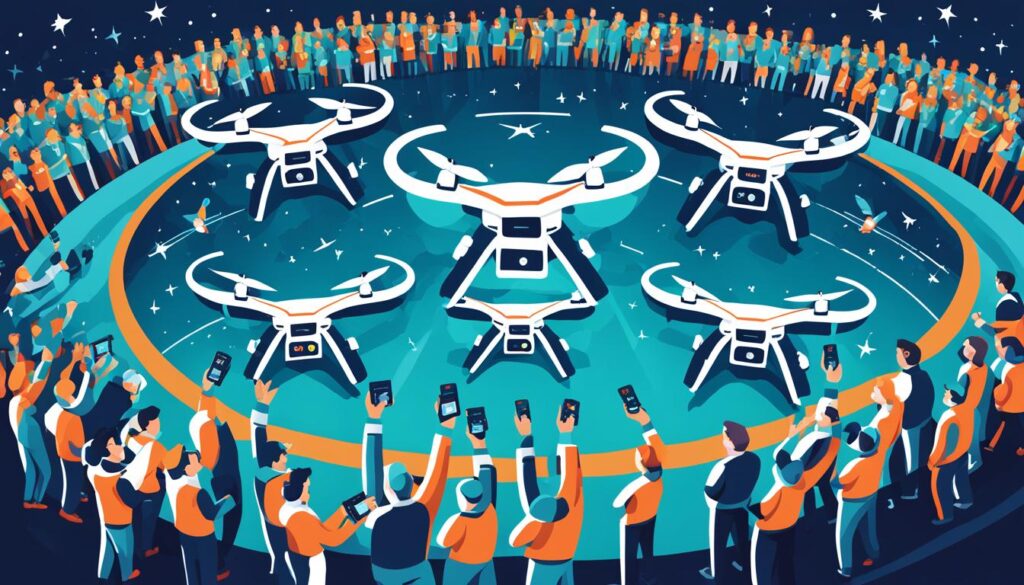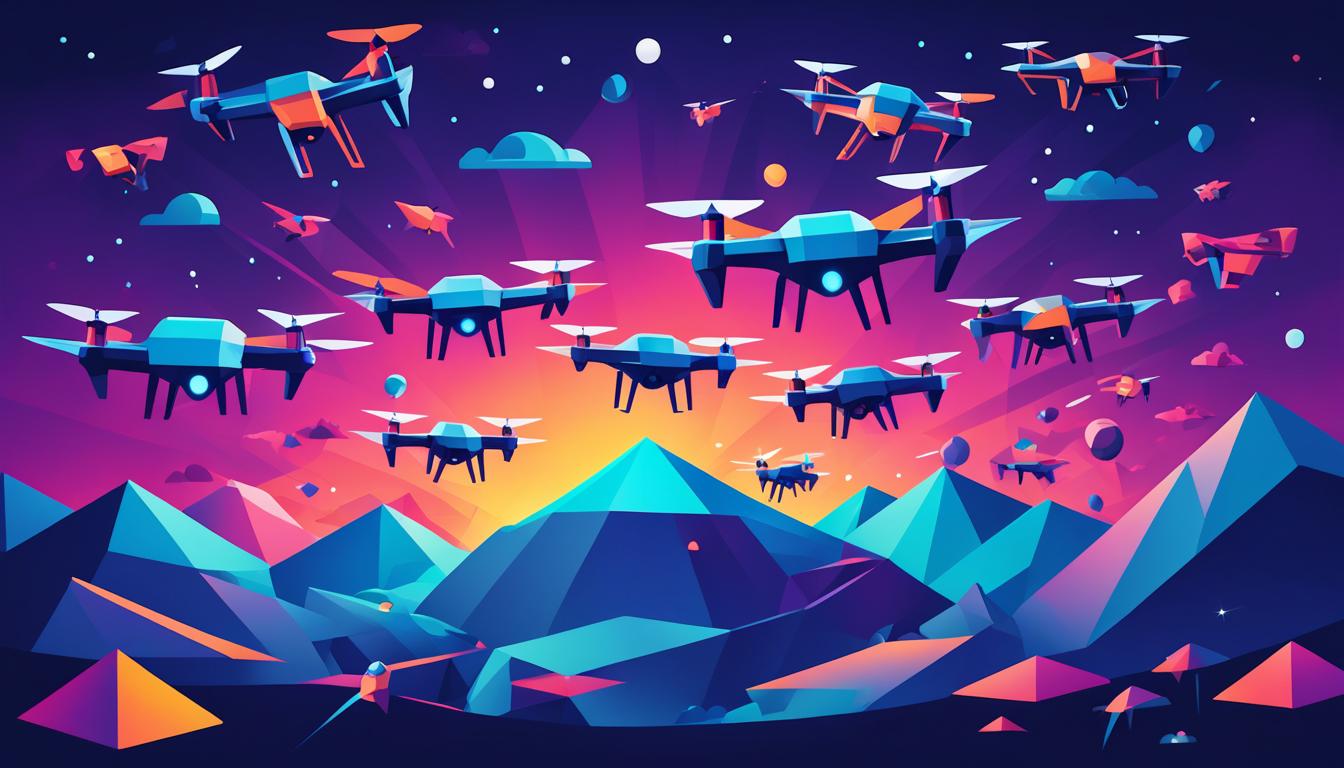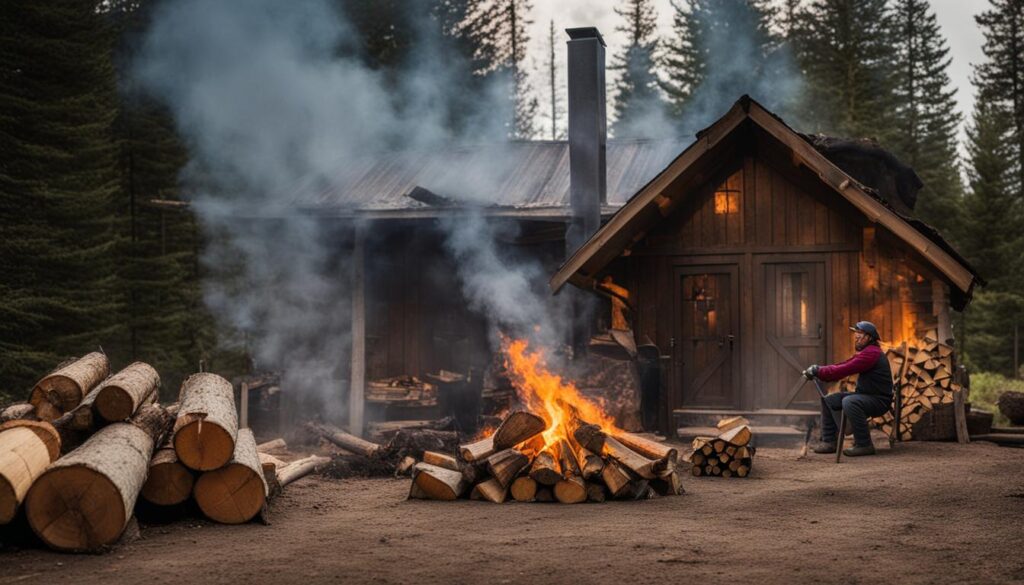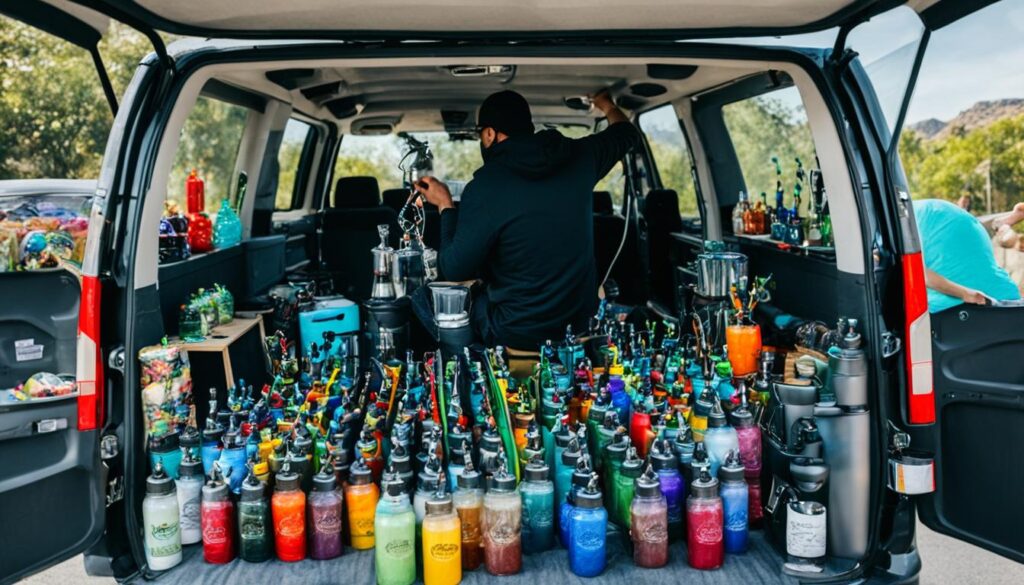In a remarkable feat, the drone light show market experienced an astounding fivefold growth in 2023, soaring to an impressive $900 million. As this captivating industry continues to take flight, aspiring entrepreneurs and technology enthusiasts are eager to learn how to start a drone light show business. Launching a successful venture in this field requires a unique blend of technical prowess, creative vision, and business savvy.
To embark on this exciting journey, you’ll need to navigate a series of crucial steps. From obtaining the necessary certifications and licenses to investing in cutting-edge drone light show equipment, each decision plays a vital role in your business’s success. Building a skilled team of professionals is paramount, as drone light show planning and execution demand precise coordination and flawless performance.
As you develop your unique value proposition and craft effective marketing strategies, you’ll be well on your way to establishing a thriving commercial drone services enterprise. Industry leaders like Sky Elements are paving the way, showcasing the awe-inspiring potential of drone formation flying and drone show logistics. By mastering the intricacies of drone light show software and adhering to drone light show regulations, you can create mesmerizing aerial light displays that captivate audiences across the nation.
Key Takeaways
- The drone light show market experienced a fivefold growth in 2023, reaching $900 million
- Starting a drone light show business requires technical expertise, artistic vision, and business acumen
- Obtain necessary certifications and licenses, invest in high-quality equipment, and build a skilled team
- Develop a unique value proposition and craft effective marketing strategies
- Master drone light show software and adhere to regulations to create captivating aerial displays
Understanding the Drone Light Show Market
The drone light show market has experienced remarkable growth in recent years, with a significant surge in demand and industry size. In 2023, the market witnessed an impressive fivefold increase, reaching a substantial value of $900 million compared to previous years. This growth can be attributed to the increasing popularity of drone light shows as a captivating form of entertainment and a powerful tool for brand promotion.
As a drone show provider, it is crucial to understand the various potential markets and opportunities available within this thriving industry. By identifying and targeting specific market segments, you can effectively position your business to meet the unique needs and preferences of your clients.
Potential Markets for Drone Light Shows
The drone light show market offers a wide range of opportunities across various industries and sectors. Some of the key potential markets for drone light shows include:
- Commercial shows for brand promotion and product launches
- Public celebrations and festivals
- Sports events and stadium entertainment
- Private events and celebrations
- Country and city projects for tourism and cultural promotion
Each of these market segments presents unique challenges and opportunities, requiring a tailored approach to meet the specific requirements and expectations of the clients.
Analyzing Regional Demand and Competition
Before entering the drone light show business, it is essential to conduct a thorough analysis of the regional demand and competition. Understanding the local market dynamics, consumer preferences, and existing players in the industry can help you make informed decisions and develop effective strategies.
To analyze regional demand, consider factors such as the popularity of drone light shows in the area, the presence of potential clients and industries, and the overall economic and cultural landscape. This information can help you identify untapped opportunities and tailor your services to meet the specific needs of the local market.
Additionally, evaluating the competition is crucial to differentiate your business and gain a competitive edge. Research the existing drone light show providers in the region, assess their strengths and weaknesses, and identify areas where you can offer unique value propositions. By understanding the competitive landscape, you can position your business strategically and attract clients looking for innovative and high-quality drone light show services.
Choosing the Right Drones for Your Business
When embarking on your journey to start a drone light show business, one of the most crucial decisions you’ll make is choosing the right drones for your shows. The success of your aerial displays hinges on the technical capabilities, performance, and reliability of your drone fleet. As you navigate the process of selecting drones, consider the following key factors:
Assessing Drone Technical Capabilities
Before investing in drones, thoroughly assess their technical capabilities to ensure they meet the specific requirements of your drone shows. Consider factors such as:
- Brightness of drone lights (aim for a minimum of 1000 lumens)
- GPS capabilities for precise positioning during maneuvers
- Reliable communication systems for seamless coordination
- Robust flight hardware for stable and safe performances
Balancing Drone Costs and Performance
Finding the right balance between drone costs and performance is essential for the financial viability of your business. While investing in high-quality drones is crucial, it’s equally important to manage your budget effectively. Consider the following tips:
- Research and compare prices from reputable drone manufacturers
- Prioritize drones with the essential features for your shows
- Opt for reliable UAV manufacturers instead of producing drones in-house
- Factor in maintenance and repair costs when budgeting for your drone fleet
Considering Drone Size, Weight, and Flight Time
The size, weight, and flight time of your drones play a significant role in the logistics and execution of your drone shows. Keep these factors in mind when making your selection:
- Choose drones that are compact and lightweight for easy transportation and setup
- Ensure the drones have sufficient flight time to accommodate the duration of your shows
- Consider the venue type and desired visual impact when determining the appropriate drone size
- Opt for drones with modular designs for easy maintenance and customization
By carefully assessing drone technical capabilities, balancing costs and performance, and considering factors like size, weight, and flight time, you’ll be well-equipped to choose the ideal drones for your business. Remember, investing in reliable, high-quality drones is the foundation for creating mesmerizing aerial displays that will captivate your audiences and set your business apart in the competitive drone show market.
Mastering Drone Show Animation
Creating captivating drone show animations requires a perfect blend of artistic vision and technical expertise. To bring your ideas to life, you’ll need to master the art of 3D animation and utilize specialized software designed for drone light shows. By harnessing the power of these tools, you can craft mesmerizing aerial displays that will leave your audience in awe.
Creating Animations with Blender
Blender is a powerful, open-source 3D creation suite that offers a comprehensive set of tools for crafting lifelike drone animations. With its intuitive interface and vast array of features, Blender allows you to:
- Model and texture custom drone designs
- Create complex animations and flight paths
- Simulate realistic lighting and environmental effects
- Render high-quality animations for seamless integration into your drone show
By mastering Blender, you can bring your creative visions to life and create stunning drone show animations that will captivate your audience.
Utilizing Drone Show Creator Software
While Blender is an essential tool for creating drone animations, specialized software like Drone Show Creator can streamline the production process and optimize the technical aspects of your show. Drone Show Creator is designed to:
- Create precise takeoff and landing formations
- Link key scenes and transitions seamlessly
- Maintain safe speeds and distances between drones
- Export animations in formats compatible with your drone fleet
By utilizing Drone Show Creator in conjunction with Blender, you can ensure that your drone show animations are not only visually stunning but also technically sound and safe to execute.
Building a Skilled Drone Show Team
The success of your drone show business relies heavily on the expertise and dedication of your drone show team. As you embark on this exciting venture, it is crucial to assemble a group of skilled professionals who can fulfill specific roles and contribute to the seamless execution of your aerial displays.

When building your drone show team, consider the following key positions:
- Drone Show Pilot: The pilot is responsible for safely flying the drones and ensuring they follow the predetermined choreography. They must possess extensive experience in drone operation and be well-versed in the specific requirements of drone light shows.
- Drone Specialist/Co-Pilot: The drone specialist or co-pilot assists the main pilot in managing the drones during the show. They help with pre-flight checks, battery management, and troubleshooting any technical issues that may arise.
- Executive Producer: The executive producer oversees the entire drone show project, from initial client communication to the final performance. They coordinate with the creative team, manage logistics, and ensure that the show meets the client’s expectations.
- Creative Mind/Battery Manager: The creative mind is responsible for designing the visual elements of the drone show, such as animations and formations. They work closely with the battery manager, who ensures that all drones are properly charged and ready for the performance.
Each team member plays a vital role in the overall success of your drone show business. By carefully selecting skilled professionals who are passionate about their work and committed to delivering exceptional results, you can create a strong foundation for your company’s growth and success in the aerial entertainment industry.
Essential Steps to Launch Your Drone Show Business
Launching your first drone show requires careful planning and preparation to ensure a successful and safe performance. As you embark on this exciting journey, there are several crucial steps you need to take to establish a solid foundation for your drone show business.
Selecting Your Drone Show Package
When starting your drone show business, it’s essential to choose a drone show package that aligns with your specific needs and budget. Consider factors such as the number of drones required, the complexity of the show, and the desired visual impact. Investing in a comprehensive package that includes high-quality drones, reliable communication systems, and robust flight hardware will set you up for success.
Completing Drone Show Training and Certification
To ensure the safety and professionalism of your drone shows, it’s crucial to undergo thorough training and obtain the necessary certifications. Engage in comprehensive drone show training programs that cover various aspects, including:
- Drone operation and maintenance
- Animation creation and programming
- Safety protocols and emergency procedures
- Regulatory compliance and flight permits
Upon completing the training, take the certification test to validate your skills and knowledge. Being a certified drone show operator will instill confidence in your clients and demonstrate your commitment to excellence.
Designing a Detailed Drone Show Plan
A well-designed drone show plan is the backbone of a successful performance. Take the time to create a comprehensive plan that encompasses all aspects of the show, including:
- Concept development and show design
- Site evaluation and safety assessment
- Flight path planning and drone formations
- Music and visual synchronization
- Contingency plans and risk management
Collaborating with your team and clients during the planning process will ensure that the show meets their expectations and aligns with the event’s overall theme.
Obtaining Necessary Flight Permits and Approvals
Before launching your drone show, it’s essential to obtain all the necessary flight permits and approvals from relevant authorities. Research and adhere to local regulations regarding drone operations, airspace restrictions, and event-specific requirements. Work closely with your clients to gather the required documentation and submit applications well in advance to avoid any last-minute complications.
Once you have secured the flight permits, coordinate with your team to ensure seamless equipment delivery, setup, and on-site preparations. Conduct thorough pre-flight checks, perform several test flights, and optimize your workforce’s productivity to guarantee a flawless performance on the day of the show.
By following these essential steps and paying attention to every detail, you’ll be well-prepared to launch your drone show business and deliver captivating aerial displays that leave a lasting impression on your audience.
Ensuring Safety in Drone Light Shows
When it comes to starting a drone light show business, safety should always be the top priority. Professional drone show teams adhere to strict safety guidelines and regulations to ensure a secure and enjoyable experience for both the audience and the performers. By implementing fundamental safety measures, such as maintaining safe distances, establishing perimeters, and incorporating redundancy in communication systems, drone shows can be conducted with the utmost safety.
Maintaining Safe Distances and Establishing Perimeters
One of the key aspects of drone show safety is maintaining a safe distance between the drones and the audience. This is achieved by establishing a perimeter around the flight area, preventing spectators from getting too close to the drones. The size of the perimeter depends on factors such as the number of drones, their size, and the complexity of the show. As a drone show operator, you should work closely with event organizers to determine the appropriate perimeter size and ensure that it is clearly marked and enforced throughout the event.
Implementing Redundancy in Communication Systems
Another crucial element of drone show safety is the implementation of redundancy in communication systems. This means having backup systems in place to ensure that the drones can communicate with each other and with the ground station, even if the primary system fails. Redundancy can be achieved through the use of multiple communication channels, such as radio frequency and cellular networks, as well as by incorporating backup drones that can take over if a primary drone malfunctions.
Leading drone show providers, such as Sky Elements, prioritize safety by employing redundancy in their communication systems and using backup drones to minimize the risk of show disruptions. They also carefully design flight paths to ensure that the drones maintain safe distances from each other and from any obstacles in the flight area.
To further enhance safety, consider the following best practices:
- Use high-quality drones with reliable GPS capabilities for precise positioning during intricate maneuvers
- Prioritize drones with longer battery life to sustain extended performances
- Choose drones with white color and high-intensity LEDs to produce vivid and dynamic light displays while maintaining visibility
- Work with specialized UAV manufacturers that offer reliable options suitable for your budget and safety requirements
By prioritizing safety and implementing these measures, you can ensure that your drone light shows are not only visually stunning but also secure for everyone involved.
Selecting an Optimal Flight Location
When planning a drone light show, site selection is crucial to ensure the safety of both the drones and the audience. The flight location should provide ample space for the drones to maneuver while maintaining a safe distance from spectators. To achieve this, the drone show team will carefully assess the area and establish a perimeter around the designated flight zone, preventing any potential accidents or disruptions.
In addition to considering the safety of the audience, the drone show staff will also prioritize airspace safety when choosing a flight location. This involves ensuring that the selected area is free from obstacles such as trees, buildings, or power lines that could interfere with the drones’ flight paths. The team will also check for any nearby airports, heliports, or other restricted airspaces to avoid any potential conflicts with manned aircraft.
To further enhance airspace safety, the drone show pilot will create geofences before the performance. These virtual boundaries are programmed into the drones’ software, preventing them from straying beyond the designated flight zone. By implementing these geofences, the pilot can ensure that the drones remain within the safe operating area, minimizing the risk of any unintended deviations or accidents.
When evaluating potential flight locations, the drone show team will consider several key factors, including:
- Adequate space for the drones to fly and maintain a safe distance from the audience
- Clear airspace free from obstacles and potential hazards
- Compliance with local regulations and restrictions regarding drone operations
- Accessibility for the drone show crew and their equipment
- Optimal visibility for the audience to enjoy the aerial display
By carefully selecting an appropriate flight location and implementing robust safety measures, drone show providers can create a secure environment for both the drones and the spectators. This attention to detail ensures that everyone can enjoy the mesmerizing beauty of a drone light show without compromising on safety or airspace regulations.
The Drone Show Planning Process
Orchestrating a captivating drone light show requires meticulous planning and coordination among various team members. The process involves several stages, each crucial to ensuring a successful and safe performance. From concept development and show design to programming and rehearsals, every step demands attention to detail and a collaborative effort.

Concept Development and Show Design
The foundation of any mesmerizing drone light show lies in the concept development and show design phase. This is where your creative vision takes shape, and you begin to craft a unique narrative that will captivate your audience. Consider the following aspects during this stage:
- Defining the theme and storyline of your show
- Sketching out the key visual elements and formations
- Selecting the appropriate music and synchronizing it with the drone movements
- Determining the optimal number of drones required to bring your vision to life
Collaborating closely with your clients during the concept development phase is essential to ensure that the show aligns with their expectations and the event’s overall theme.
Programming and Rehearsals
Once the show design is finalized, the next critical step is programming the drones and conducting thorough rehearsals. This phase involves translating the creative concept into precise flight paths and coordinated movements for each drone. Here’s what you can expect during programming and rehearsals:
- Utilizing specialized software to create detailed flight patterns and animations
- Testing and refining the drone formations to ensure smooth transitions and optimal visual impact
- Conducting multiple rehearsals to synchronize the drones with the music and perfect the timing
- Addressing any technical challenges or safety concerns that may arise during the rehearsal process
The duration of the programming and rehearsal phase can vary depending on the complexity of the show and the number of drones involved. It’s crucial to allocate sufficient time for this stage to ensure a flawless performance on the day of the event.
Planning a drone light show is a multi-faceted process that requires a blend of artistic vision, technical expertise, and logistical coordination. From concept development and show design to programming and rehearsals, each stage plays a vital role in creating an unforgettable aerial spectacle. By dedicating adequate time and attention to every aspect of the planning process, you can deliver a truly mesmerizing drone light show that will leave your audience in awe.
Determining the Scale of Your Drone Light Show
When planning a drone light show, one of the key factors to consider is the scale of the performance. The visual impact of your show directly correlates with the number of drones employed. Smaller events, such as intimate gatherings or private celebrations, may require as few as 100 drones to create a captivating display. On the other hand, large-scale productions, like festivals or citywide celebrations, might necessitate hundreds or even thousands of drones to achieve a truly awe-inspiring spectacle.
The drone show scale is not only determined by the number of drones but also by the available airspace and the desired visual impact. When working with a limited airspace, a skilled drone show provider can still create an impressive display by carefully choreographing the movements of a smaller fleet. However, if you aim to cover vast areas of the sky and create intricate formations, a larger number of drones will be necessary.
It’s essential to keep in mind that the cost of a drone light show is directly influenced by its scale. Prices for these performances can range from around $15,000 for smaller shows to significantly higher amounts for more elaborate productions, as detailed in this comprehensive guide on everything you need to know about drone light shows. The complexity of the show, the number of drones required, and the logistical aspects all contribute to the overall expense.
When collaborating with a professional drone show provider like Sky Elements, you can expect expert guidance in determining the optimal scale for your event. Their team will take into account factors such as your budget, the desired visual impact, and the venue’s characteristics to create a customized proposal that meets your needs and exceeds your expectations.
By carefully considering the scale of your drone light show and working with experienced professionals, you can ensure that your event will feature a mesmerizing aerial display that leaves a lasting impression on your audience.
Tailoring Show Duration to Client Needs
When it comes to creating a captivating drone light show, the duration of the performance is a crucial factor to consider. The length of the show can greatly impact the overall experience for the audience and the effectiveness of the event. At Sky Elements, we understand the importance of tailoring the show duration to meet the specific needs and requirements of our clients.
Typical Drone Show Lengths
While there is no one-size-fits-all answer to the ideal duration of a drone light show, most performances typically last between 8 to 12 minutes. This timeframe allows for a dynamic and engaging display that captures the audience’s attention without overwhelming them. Within this range, we can create a well-balanced show that showcases a variety of formations, transitions, and visual effects, leaving a lasting impression on the spectators.
Customizing Shows for Specific Events
At Sky Elements, we recognize that every event is unique, and the duration of the drone light show should be customized to suit the specific needs of the event organizer. Whether you’re planning a corporate event, a music festival, a product launch, or a private celebration, we work closely with you to understand your vision and tailor the show duration accordingly.
Our team of experienced drone show specialists will collaborate with you to determine the optimal length of the performance based on factors such as:
- The overall theme and message of the event
- The desired impact and emotional response from the audience
- The allocated time slot for the drone light show within the event schedule
- The complexity and intricacy of the custom-designed formations and animations
By taking these elements into consideration, we can create a drone light show that seamlessly integrates with your event, enhancing the overall experience and leaving a lasting impression on your attendees. Our flexibility in show duration allows us to accommodate a wide range of client needs and event requirements, ensuring that your drone light show is a perfect fit for your occasion.
It’s worth noting that the time required to set up the drones on-site for a drone show can vary depending on the number of drones involved, the complexity of the show, and the experience of the crew. Generally, the setup process can take anywhere from a few hours to a full day of preparation. Our team at Sky Elements is highly efficient and well-versed in the setup process, ensuring that everything is in place and ready for a flawless performance, no matter the duration of the show.
Navigating Drone Light Show Regulations
As you embark on your journey to start a drone light show business, it’s crucial to understand and navigate the legal requirements and regulations surrounding this innovative industry. While drone light shows are regulated, many locations do not require extra approvals. However, some areas may have specific guidelines, and it’s the responsibility of the drone light show operator to obtain the necessary drone authorizations and waivers for these locations.
To ensure compliance with Federal Aviation Regulations, drone light shows must adhere to certain restrictions. These include maintaining an altitude of no more than 400 feet above ground level and ensuring a minimum visibility of 3 statute miles. In rare circumstances, the FAA may grant waivers to fly in low visibility areas or close to clouds, but obtaining these waivers requires careful consideration and documentation.
When planning your drone light show, it’s essential to consult with experienced drone light show operators who possess the required certifications and licenses. They can provide valuable guidance on navigating drone show regulations and help determine if they already have the necessary waivers or if they can obtain them for your specific event.
To further ensure compliance and professionalism, consider the following steps:
- Research and familiarize yourself with the specific drone show regulations applicable to your region and the locations where you plan to operate.
- Obtain the required certifications and licenses, such as a Remote Pilot Certificate (Part 107), to demonstrate your knowledge and commitment to safety.
- Develop a comprehensive operations manual that outlines your safety protocols, emergency procedures, and compliance with legal requirements.
- Foster open communication with local authorities, event organizers, and clients to address any concerns and ensure a smooth and compliant drone light show experience.
By prioritizing compliance with drone show regulations and collaborating with experienced professionals, you can confidently navigate the legal landscape and focus on delivering awe-inspiring aerial displays that captivate audiences while maintaining the highest standards of safety and professionalism.
How to Start a Drone Light Show Business: Key Considerations
Embarking on a drone show business venture opens up a world of possibilities, allowing you to tap into various markets and carve out a unique niche that aligns with your skills and passion. To set your business up for success, there are several key considerations to keep in mind. First and foremost, obtaining the necessary certifications and licenses is crucial to ensure compliance with regulations and establish credibility in the industry. Investing in high-quality drone equipment is equally important, as it directly impacts the quality and reliability of your shows.
Building a skilled and dedicated team is another critical aspect of starting a drone show business. Surround yourself with individuals who possess the technical expertise, creativity, and professionalism needed to deliver exceptional performances. Developing a unique value proposition is also essential to differentiate your business from competitors and attract clients. This could involve specializing in certain types of events, offering customized show designs, or providing exceptional customer service.
Before diving into the drone show business, conducting thorough market research is paramount. Examine the regional demand for drone light shows, analyze the competition, and gain a deep understanding of the specific needs and preferences of various market segments. This knowledge will help you tailor your services, pricing, and marketing strategies to effectively reach and engage your target audience. By carefully considering these key factors and planning meticulously, you can lay a solid foundation for a thriving drone show business that delivers awe-inspiring performances and exceeds client expectations.
FAQ
What are the key steps to starting a drone light show business?
How can I analyze regional demand and competition in the drone light show market?
What factors should I consider when choosing drones for my drone light show business?
What software can I use to create captivating drone show animations?
What roles are essential in a drone show team?
How can I ensure the safety of my drone light shows?
What should I consider when selecting a flight location for a drone show?
How long does it take to plan a drone light show?
What determines the size of a drone light show?
How long do drone light shows typically last?
Are there any regulations I need to be aware of when starting a drone light show business?
Author
-

Lucas Martinez is an accomplished entrepreneur with a passion for startups. He has launched and scaled multiple businesses, providing pragmatic advice on starting and growing a business.
View all posts



